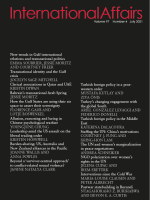How the West went from building democracies to containing threats
Western states are increasingly being explicit about their limited faith in the transformative potential of interventions. This reflects their waning belief in the applicability of liberal internationalism since the end of the Cold War. In our recent article in International Affairs we explore how interventions have been gradually reconfigured in response to the West’s unrealized strategy to achieve liberal democratic peace. We argue that the West’s continued drive to shape fragile states through intervention is increasingly conditioned by a desire to introduce distance between intervenor and intervened rather than promote democracy or support the populations they directly effect.
Distancing themselves from the consequences
The West’s reduced belief in its own transformative abilities and desire to lower the cost of intervention has been reinforced by two key developments. First, technological advances have increasingly allowed intervenors to maintain distance and avoid troop deployments, while still responding to events on the ground. Second, intervention is delegated from intervenors in the West to southern partners in a way that, from the perspective of North America and Europe, is considered safer, cheaper, and more effective.
However, this increased focus in the West on delegating the burden of intervening away from itself reduces the West’s sensitivity to the consequences of its policy decisions. Indeed, this often translates into less interest in understanding the outcomes of the intervention for those who live through it. While introducing distance limits the consequences for Western states, the same cannot be said for civilians inhabiting the areas targeted by interventions or partners in the global South that increasingly serve as proxies for the West.
The desire for distance not only reflects broader shifts in how the West sees its position in the world. It represents a shift in how it seeks to contain what it considers threats.
From the Cold War to failed interventions in the Middle East
Since the Cold War, western approaches to intervention have undergone a protracted seismic shift. The fall of the Soviet Union ushered in a period of unfettered belief in the ideological and military superiority of the liberal democratic project. This gaze on the world, often articulated as the liberal peace thesis, provided the powerful impetus for attempts to transform weak and fragile states in the image of western liberal democracies. The governance model packaged as liberal internationalism was not only considered more organizationally effective but also morally superior.
The terrorist attacks on 11 September 2001 shattered this belief in the universal desirability of liberal democratic forms of government. The result was the increased militarization of interventions as containment of hostile transnational jihadism took precedence over the conviction that building a liberal-democratic world order was a common, global project. Weak and failing states were no longer simply a threat to their own populations but to global security, and extensive externally driven statebuilding was seen as the solution — by force if necessary.
The failure of large-scale interventions in Afghanistan and Iraq led to disillusionment with the West’s superiority and transformative capacity — and to an emergent strategy of distance, outsourcing and surrogate warfare. This includes increased outsourcing to militaries in the global South and relying more heavily on technological capabilities. In this way, the West has maintained the capacity to intervene by outsourcing the kinetic element of warfighting to partners or technology such as drones as has been the case in Yemen.
The future of western intervention?
Interventions in the 1990s and 2000s were extremely intrusive. They were built on a perception that the West had the ability and moral responsibility to replace governance systems shattered by war based on universalist blueprints. Equally important was that weak and failing states were seen as having an inherent desire to go through this transformation.
Current doubts about the universal applicability of the liberal democratic state have led to downscaled forms of intervention, but not to a more fundamental questioning of whether interventions should be undertaken. Thus, despite a diminished belief in the West’s ability to transform the world, interventions continue. Indeed, the biggest change is that the explicit aim no longer is to transform targeted states but to contain the threat that they — and their populations — pose to the West. Since the 1990s, we have gone from transformative statebuilding to stabilization as a measure to contain threats.
This change in approach to interventions could simply be read as a more pragmatic understanding of the West’s transformative potential. However, the current situation requires that we ask more fundamental questions about where, how and by whom interventions will be carried out in the future. A failure to do so will leave interventions by western states stranded in an ideological limbo.
This article was originally published on the International Affairs Blog
DIIS Eksperter


